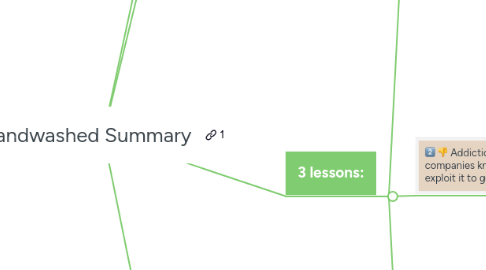
1. 1-Sentence-Summary:
1.1. Brandwashed will help you make better buying decisions by identifying the psychological tools that marketers use to turn your own brain against you and make you think that you need to buy their products.
2. Favorite quote from the author:
2.1. "The fear of failure drives consumers far more than the promise of success." - Martin Lindstrom
3. 3 lessons:
3.1. You buy things we don’t need because stores know how to use our fears against you.
3.1.1. Fear helped our ancestors with their chances of survival
3.1.1.1. They had to move fast when a threat came along, so now our brains do the same in the right circumstances.
3.1.2. The amygdala is the part of the brain that fear comes from.
3.1.2.1. This survival-driven fear instinct is so powerful that it even has the ability to slow down the rational thinking parts of our brain.
3.1.2.2. Companies know this, and they play on it frequently.
3.1.2.3. One security company aired a commercial that utilized this mechanism perfectly.
3.1.2.3.1. While a mother is making dinner in the kitchen, her children play outside. But the mom doesn’t notice the man who is eerily watching the kids.
3.1.2.3.2. The scare-factor of this ad was enough to make people go out and purchase the company’s security devices.
3.1.2.4. Some businesses use our fears against us by exaggerating how afraid we are of becoming something we don’t want to.
3.1.2.4.1. They can do this by making the issues we have to deal with seem much worse than they actually are.
3.1.2.4.2. An example:
3.2. Addiction can happen to anyone, and companies know the process well and exploit it to get you to buy.
3.2.1. Many of us can’t live without our phones or favorite foods.
3.2.1.1. This is a classic symptom of an addiction.
3.2.2. One study found out the extent of the effect that young Americans cell phone use has on their brains.
3.2.2.1. When 18-25-year-old’s devices ring, the region of the brain associated with being in love lights up.
3.2.2.2. In other words, you are in love with your phone, and it’s not by chance.
3.2.3. Shopping has these same effects but is also a little more sinister.
3.2.3.1. The high we can get from making purchases releases dopamine, which gives a feeling of well-being.
3.2.3.2. But this urges us to want more, so we spend more. It can be a difficult cycle to break.
3.2.4. Food companies know this effect well
3.2.4.1. That’s why they load their foods with unhealthy fats and sugars.
3.2.4.2. You get the same dopamine rush and next time you come back, you need more to get the same fix, so you buy more.
3.2.5. Research on rats addicted to food and cocaine has some alarming results.
3.2.5.1. In rats hooked on food, the effects of the craving continued seven times longer than the rats with drug addictions
3.2.5.2. Companies know this and will not hesitate to use your body’s ability to get addicted against you
3.3. You make some purchases because of fake peer pressure that vendors create.
3.3.1. It’s human nature that we like to follow what others are doing.
3.3.1.1. Our ancestors survived better in communities, which were easier to get into if you fit in well.
3.3.2. We learn how to use certain items based on what we see others do with them.
3.3.2.1. It’s also hard for us to avoid conforming when everybody else is following a set pattern.
3.3.2.2. We tend to want what we see most people have.
3.3.2.3. Research confirms all three of these truths about peer pressure.
3.3.3. There might be products that you own that you think you just have to have.
3.3.3.1. Without even knowing it you may think you need that iPhone or designer brand handbag because everybody else does.
3.3.3.2. But these fancy items don’t mean that you’re unique or in fashion, it’s you succumbing to businesses taking advantage of your psychology without you knowing it.
3.3.4. Reviews are one of the best tools companies use to fake peer pressure.
3.3.4.1. Have you purchased an item on Amazon that had the most and highest reviews?
3.3.4.1.1. Up to 25% of them are fake!
3.3.5. We also go crazy for items on bestseller lists because we think it means they have value.
3.3.5.1. What’s on the top charts doesn’t come from the experts.
3.3.5.1.1. It’s whoever negotiates to pay the most to get on the top.
